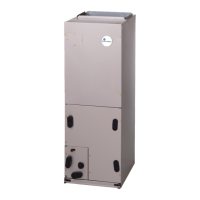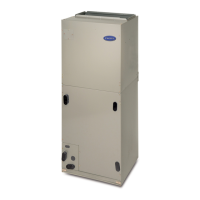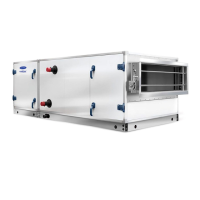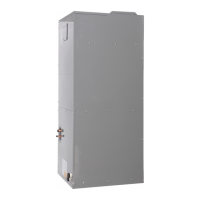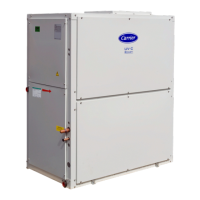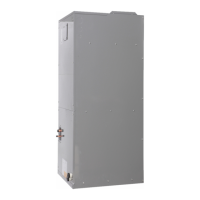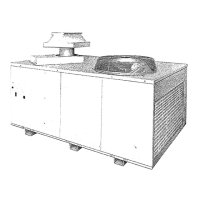64
Occupied Heating Enable (OC.EN)
This configuration only applies when the unit’s control type (Con-
figuration
UNIT
C.TYP) is configured for 1 (VAV-RAT) or 2
(VAV-SPT). If the user wants to have the capability of performing
heating throughout the entire occupied period, then this configura-
tion needs to be set to “YES.” Most installations do not require
this capability, and if heating is installed, it is used to heat the
building up in the morning. In this case, set OC.EN to “NO.”
NOTE: This unit does not support simultaneous heating and cool-
ing. If significant simultaneous heating and cooling demand is ex-
pected, it may be necessary to provide additional heating or cool-
ing equipment and a control system to provide occupants with
proper comfort.
NOTE: If the user does not relocate this sensor for the 2-stage
electric or gas heating types and is under CCN Linkage, then the
control will send a heating mode (if present) unconditionally to the
linkage coordinator in the CCN zoning system regardless of the
leaving-air temperature.
HEAT MODE SELECTION PROCESS
There are two possible heat modes that the control will call out for
heating control: HVAC Mode = LOW HEAT and HVAC Mode =
HIGH HEAT. These modes will be called out based on control
type (C.TYP).
VAV-RAT (C.TYP = 1) and VAV-SPT (C.TYP = 2)
There is no difference in the selection of a heating mode for either
VAV-RAT or VAV-SPT, except that for VAV-SPT, space tempera-
ture is used in the unoccupied period to turn on the supply fan for
10 minutes before checking return-air temperature. The actual se-
lection of a heat mode, LOW or HIGH for both control types, will
be based upon the controlling return-air temperature.
With sufficient heating demand, there are still conditions that will
prevent the unit from selecting a heat mode. First, the unit must be
configured for a heat type (Configuration
HEAT
HT.CF not
equal to “NONE”). Second, the unit must have a configuration
which can enable or disable heating in the occupied period except
for a standard morning warmup cycle (Configuration
HEAT
OC.EN). See descriptions in the Setting Up the System section on
page 63 for more information.
Tstat-Multi-Stage (C.TYP = 3)
With thermostat control the W1 and W2 inputs determine whether
the HVAC Mode is LOW or HIGH HEAT.
W1 = ON, W2 = OFF: HVAC MODE = LOW HEAT*
W2 = ON, W2 = ON: HVAC MODE = HIGH HEAT
* If the heating type is either 2-stage electric or 2-stage gas, the
unit may promote a low heat mode to a high heat mode.
NOTE: If W2 = ON and W1 is OFF, a “HIGH HEAT” HVAC
Mode will be called out but an alert (T422) will be generated. See
Alarms and Alerts section on page 122.
SPT Multi-Stage (C.TYP = 4)
The unit is free to select a heating mode based on space tempera-
ture (SPT).
If the unit is allowed to select a heat mode, then the next step is an
evaluation of demand versus set point. At this point, the logic is
the same as for control types VAV-RAT and VAV-SPT, (C.TYP =
1,2) except for the actual temperature compared against set point.
See Temperature Driven Heat Mode Evaluation section.
TEMPERATURE DRIVEN HEAT MODE EVALUATION
This section discusses the technique for selecting a heating mode
based on temperature. Regardless of whether the unit is config-
ured for return air or space temperature, the logic is exactly the
same. For the rest of this discussion, the temperature in question
will be referred to as the controlling temperature.
First, the occupied and unoccupied heating set points under Set-
points must be configured.
Then, the heat/cool set point offsets under Configuration
D.LV.T should be set. See Table 43.
Related operating modes are under Operating Modes
MODE.
.
The first thing the control determines is whether the unit is in the
occupied mode (OCC) or in the temperature compensated start
mode (T.C.ST). If the unit is occupied or in temperature compen-
sated start mode, the occupied heating set point (OHSP) is used.
In all other cases, the unoccupied heating set point (UHSP) is
used.
The control will call out a low or high heat mode by comparing
the controlling temperature to the heating set point and the heating
set point offset. The set point offsets are used as additional help in
customizing and tweaking comfort into the building space. See
Fig. 7 for an example of offsets.
Demand Level Low Heat on Offset (L.H.ON)
This is the heating set point offset below the heating set point at
which point Low Heat starts.
Demand Level High Heat on Offset (H.H.ON)
This is the heating set point offset below [the heating set point mi-
nus L.H.ON] at which point high heat starts.
Table 43 — Heat/Cool Set Point Offsets
ITEM EXPANSION RANGE UNITS CCN POINT DEFAULT
OHSP Occupied Heat Setpoint 55 to 80 dF OHSP 68
UHSP Unoccupied Heat Setpoint 40 to 80 dF UHSP 55
ITEM EXPANSION RANGE CCN POINT
MODE MODES CONTROLLING UNIT
OCC Currently Occupied ON/OFF MODEOCCP
T.C.ST Temp.Compensated Start ON/OFF MODETCST
ITEM EXPANSION RANGE UNITS CCN POINT DEFAULT
D.LV.T COOL/HEAT SETPT. OFFSETS
L.H.ON Dmd Level Lo Heat On –1 to 2 ^F DMDLHON 1.5
H.H.ON Dmd Level(+) Hi Heat On 0.5 to 20.0 ^F DMDHHON 0.5
L.H.OF Dmd Level(-) Lo Heat Off 0.5 to 2 ^F DMDLHOFF 1
L.C.ON Dmd Level Lo Cool On –1 to 2 ^F DMDLCON 1.5
H.C.ON Dmd Level(+) Hi Cool On 0.5 to 20.0 ^F DMDHCON 0.5
L.C.OF Dmd Level(-) Lo Cool Off 0.5 to 2 ^F DMDLCOFF 1
C.T.LV Cool Trend Demand Level 0.1 to 5 ^F CTRENDLV 0.1
H.T.LV Heat Trend Demand Level 0.1 to 5 ^F HTRENDLV 0.1
C.T.TM Cool Trend Time 30 to 600 sec CTRENDTM 120
H.T.TM Heat Trend Time 30 to 600 sec HTRENDTM 120

